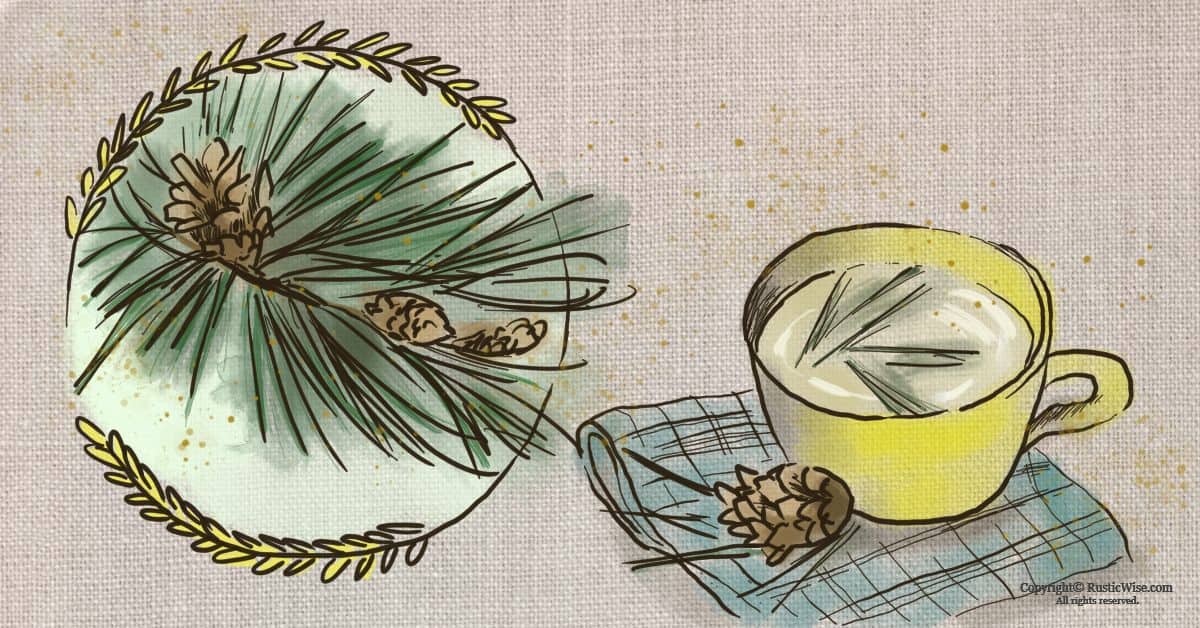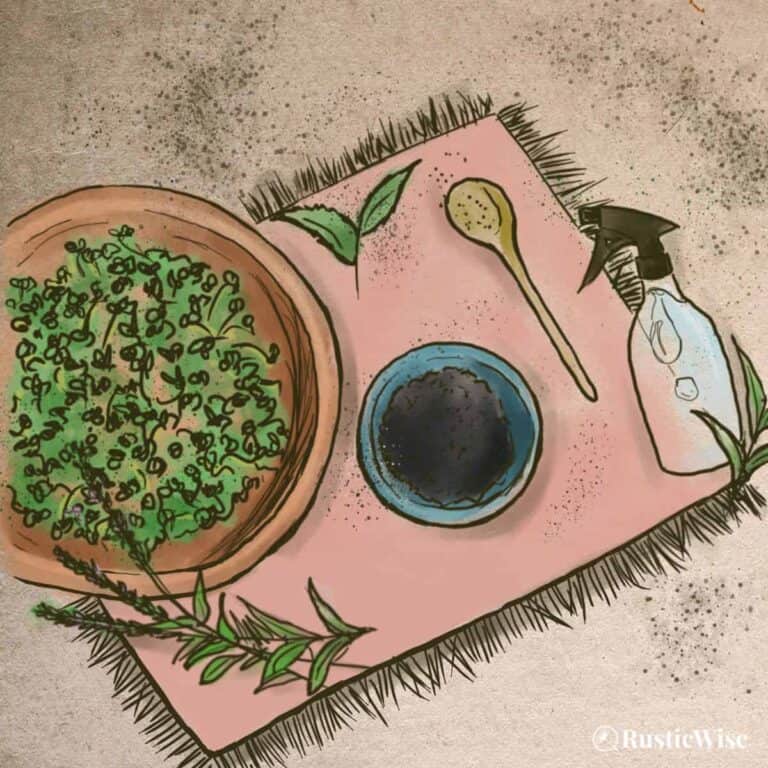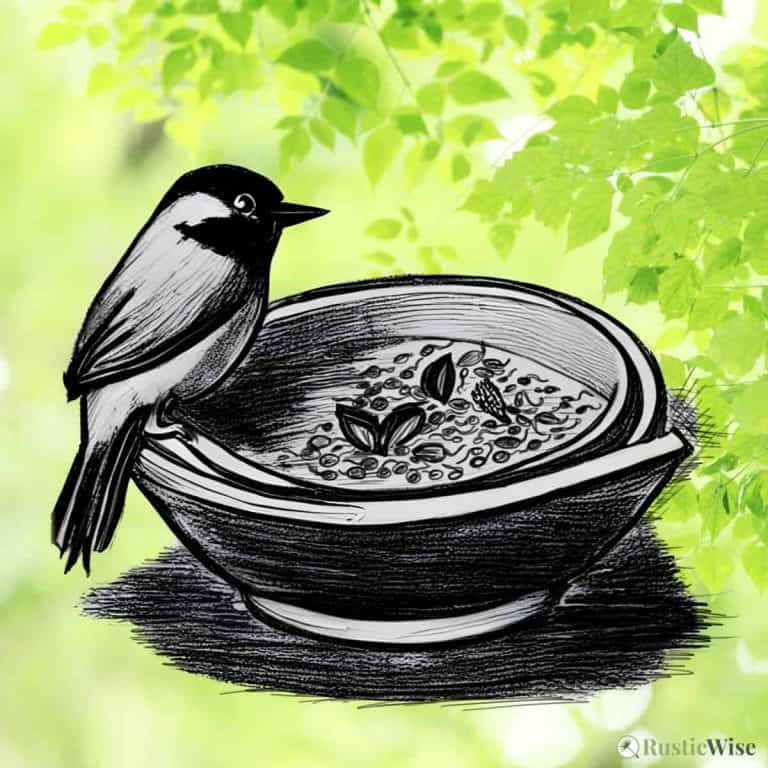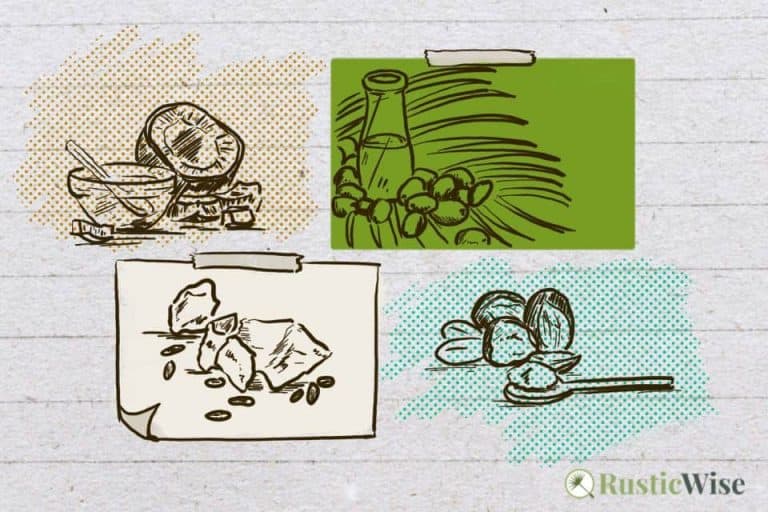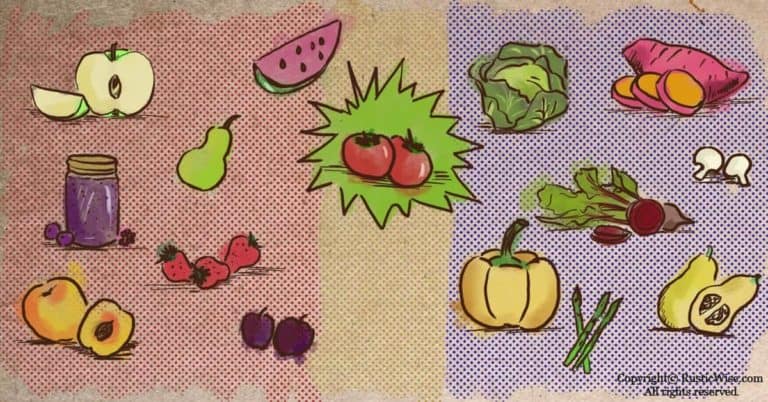Foraging Pine Needles: Pine Needle Tea Recipe & Cooking Ideas
RusticWise is supported by its readers. When you purchase through links on our site, we may earn an affiliate commission. As an Amazon Associate, we earn from qualifying purchases. Thank You!
When most people think of pine trees they think of Christmas trees, or perhaps artificially-scented pine household cleaners. Fewer people know about the edible properties of conifers. Their edible and medicinal uses are true gifts to us.
Pine trees belong to a group of wild edible conifers, which also includes spruce and fir trees. Foraging pine needles is available to anyone looking to harvest nature’s bounty. The needles of these trees are used for a variety of purposes, such as cooking, baking, garnishing, and brewing pine tea.
Let’s learn all about pine needles, from how to forage them, to what to do with them, including how to make pine needle tea. Plus, there’s a roundup of five pine needle recipes so you can enjoy cooking with pine.
What parts of the pine tree are edible?
Most of us are familiar with pine nuts, but did you know that other parts of the pine tree are edible too, including the needles, bark, pollen, and even pine cones.
- Inner bark: According to the American Conifer Society, the soft, white inner bark found clinging to the rough outer exterior is edible. It’s packed with vitamins A and C. You can enjoy the inner bark raw as a sweet, tasty snack (handy if you ever find yourself in a survival situation!). Or, it can be dried up and ground into powder and added to soups, stews, or bread. The bark also can be cut into strips, and used like spaghetti.¹
- Pine cones: The female cones (the ones that contain the seeds) are tasty when peeled and roasted. Male cones have a potent flavor that’s best used if cooking with pine and other foods.²
- Pine nuts (seeds): Most pine trees produce small seeds that aren’t worth all the trouble of extracting them. But, there are several species that produce larger pine nuts: Korean Pine (P. koraiensis), Italian Stone Pine (P. pinea), and Pinyon Pine (P. edulis).²
- Pine pollen: The male pine cones produce ample amounts of pollen that can be easily collected. It has a slightly nutty and savory taste, but requires some patience when foraging! Incorporate into baking recipes or into savory dishes.
- Pine needles: Collect these edible needles to brew a cup of herbal tea high in vitamin A and C. In Sweden, this tea is called tallstrunt. There are also many culinary uses of needles, as I’ll share with you further below.
- Pine sap: In springtime, tap the trees for a sweet, syrupy treat to chew on. Or, you can make a sweet beverage of it.
What do fresh pine needles taste like?
Pine needles have a stronger, more woodsy flavor profile than spruce and fir which tastes more citrus-y.
Try collecting tender spruce tips in the spring for a surprisingly lemony snack.
Can you eat pine needles raw?
Yes, these coniferous needles are safe to eat uncooked.
If you are hiking in the woods and find yourself with hunger pains, you can chew pine needles and ingest the juices. The needles don’t taste bad, but because they’re starchy, most people don’t eat them.²
How to tell the difference between pine, spruce, and fir trees
Properly identifying the tree is the most important step when foraging your own conifer needles. People often confuse pine trees with other conifers such as spruce and fir (which are also edible by the way). Here are a few quick tips on how to tell the difference between these three types of evergreens:³
- Pine trees are characterized by their long needles, typically longer than that of spruce or fir. Needles grow in clusters of two, three, or five. Fir and spruce tree needles grow individually.
- Fir trees have softer needles and won’t hurt you if you brush up against them. Fir branches have needles that grow on opposite sides so branches appear flatter. Each individual needle is also flatter. If you pluck off an individual needle, it should lie flat on your hand and not roll.
- Spruce trees have sharper and spikier needles that will hurt when brushed up against. Spruce needles grow around each branch in all directions and are round. An individual needle will roll easily in your hand.
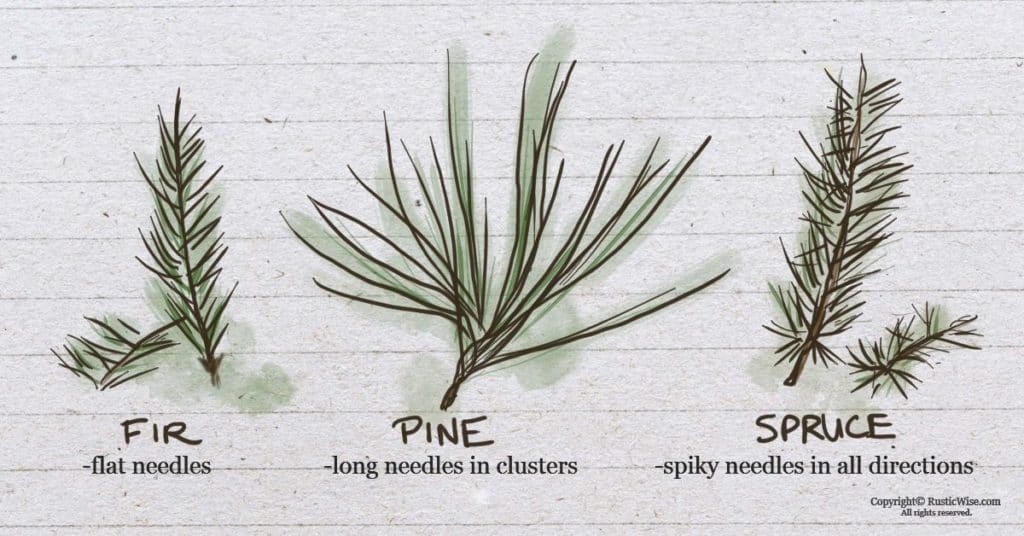
What types of pine needles are edible?
Most native conifers in Canada and the US are edible.
Depending on where you live, a few common edible varieties of pine include:
- Eastern white pine (Pinus strobus): Found in the eastern parts of North America, all parts of the white pine are edible. Eastern white pine needles differ from others as it grows needles in clusters of 5 with a telltale stripe running down each one. The needles are soft and bendable. Look for greyish colored bark. The resins in the bark may cause skin sensitivities in some people. Apparently the resins make a good glue.⁴
- Pinyon pine (Pinus edulis): This drought-tolerant tree is found in desert mountainous regions throughout California, New Mexico, and Texas. The term “edulis” means edible. The pine nut from the Pinyon tree is highly sought after for its taste and nutrients. The edible pine needles, seeds, and cones also are an important source of food for wildlife.⁵
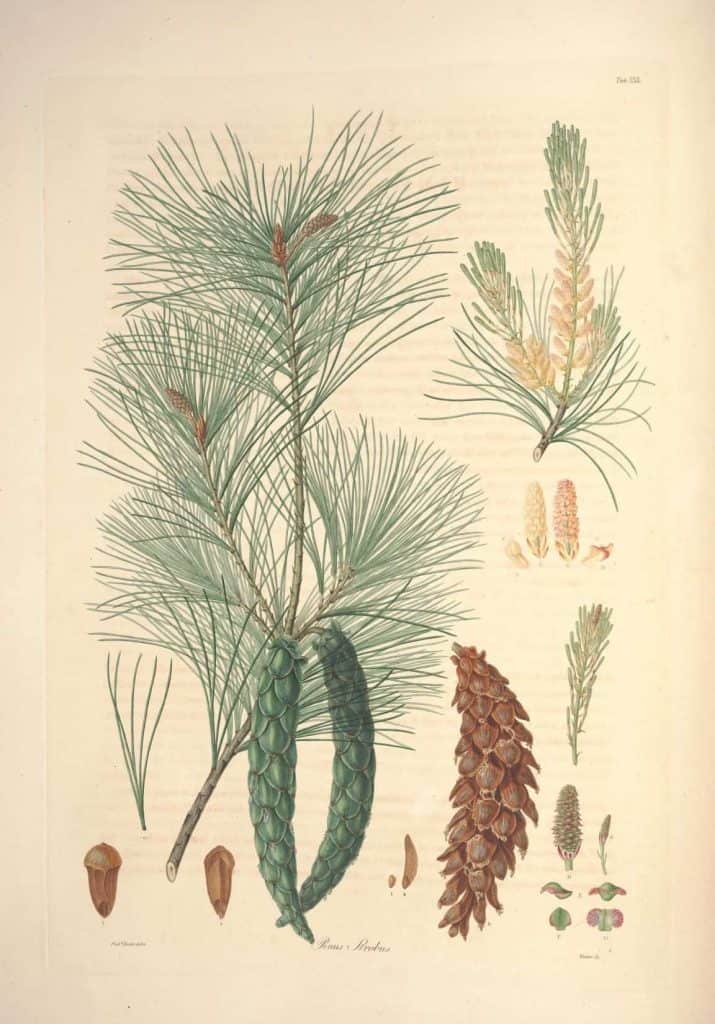
Credit: Biodiversity Heritage Library / Flickr
Types of pine trees to avoid
There are a few species of pine to AVOID, along with a dangerous lookalike:⁶
- Yew tree: With its distinct red berries and scaly bark, this species is deadly to consume.
- Ponderosa pine (Pinus ponderosa): Contains isocupressic acid that induces labor in cattle—not recommended for pregnant women.
- Lodgepole pine (Pinus contorta): Also contains isocupressic acid.
- Norfolk pine (Araucaria heterophylla): Not technically a “true pine,” although said to be potentially poisonous, particularly for dogs and cats. If you have furry friends, make sure they’re not ingesting any needles from this species of pine.
Tips for foraging pine needles
Pine trees grow throughout most of the Northern hemisphere.
According to the book Foraged Flavor by Tama Matsuoka Wong and Eddy Leroux, the best time to gather pine needles is in early spring when you can smell the fragrant pine sap. If you go in springtime, you’ll be able to benefit from new growth and pick a few young spruce tips along with your pine needles while you’re at it.⁷
(You can also harvest pine needles in the winter, although you won’t see any young needles anymore, and you’ll be cold outside!)
She favors the needles of white pine for cooking with. White pine needles have five long needles in each cluster.
Bring a pair of sharp scissors to snip the branches. Select branches with thinner clusters of needles as these crumble more easily.
When foraging, it’s always wise to abide by a few guidelines:
- Ensure you’ve properly identified the tree before consuming.
- Ensure the area you’re foraging in isn’t treated with chemicals or pesticides.
- Avoid harvesting anywhere along roadways and farmer’s fields to stay clear of pollutants.
- Practice good stewardship by not over harvesting from a particular tree or area.
Pine needle benefits
Pine needles, as well as needles of other conifers, are rich in vitamins A and C. Raw conifer needles purportedly contain more vitamin C than most citrus fruits.¹
Vitamin C has many health benefits. It boosts the immune system, protects against cardiovascular disease, and is great for the eyes and skin.⁸
Pine needles are most commonly used to make tea. Pine needle tea (referred to as tallstrunt in Sweden) is used for medicinal purposes to soothe a sore throat when you’re feeling sick, and to also open airways.
How to make pine needle tea
Safety Note: If you are pregnant or breastfeeding, do not consume pine needle tea. Please consult with your doctor before drinking pine needle tea.
Once you’ve gathered some branches, you’ll want to rinse them thoroughly in water to clean them. Afterwards, remove the pine needles. The pine needles come off easily by plucking them.
Here’s a flavor tip: Younger pine needles have a more delicate flavor, whereas needles from mature branches have a stronger, more bitter taste. If you’re looking for young pine needles, harvest the light green needles at the tips of each branch. To help release the pine-y flavor, try gently mashing the needles with a mortar and pestle.
Depending on the type of pine tree you’ve harvested from, you’ll have varying lengths of needles. Feel free to cut them into smaller pieces—kitchen shears work well for this job.
Pine needle tea recipe
- Boil 2-4 cups of water. For every one cup of water, add roughly two tablespoons of pine needles.
- Let the pine needles steep for 10-15 minutes. If you have a teapot with a strainer, this is perfect. Otherwise, you can add the pine needles directly to your mug.
- Strain and enjoy!
Sweeten with honey or a sweetener of your choice, or enjoy on its own. If the flavor of pine is lacking, you’ll want to add more pine needles and allow it to steep longer.
Cooking with pine needles 5 ways
With their aromatic woodsy scent and earthy, herbal flavor, these needles pair nicely with light meals such as white fish or chicken. Many recipes call for pine, but spruce and fir can sometimes be swapped in too.
1. Pine Needle Oil
Here’s a fragrant oil great for brushing onto fish or chicken prior to grilling or roasting (via WNYC).
2. Pine Needle Shortbread Cookies
The ultimate Christmas cookie with hints of pine and citrus. This recipe is vegan-friendly too (via A Virtual Vegan).
3. Pine Needle Vinegar
A simple, yet delicious recipe that infuses the scent and flavor of pine with apple cider vinegar. Add to salad dressings for a citrus-y splash. (via The Seasonal Table).
4. Smoked salmon in pine needles
Use fresh or dried needles to infuse salmon with a lovely woodsy flavor.
5. Northeastern Kvass
From the Wildcrafting Brewer, this kvass recipe (fermented drink) is as wild and woodsy as you can get (via ACF Chefs).
Other uses of pine needles
Besides brewing tea and cooking or baking with pine needles, there are loads of other ways to use pine needles around your home. Here are some ideas:
- Move over Pine-Soil—make your own pine vinegar for cleaning solution with real pine needles, not the chemical stuff.
- Use pine needles as a mulch in your landscaping instead of traditional wood. Spread them around your flower beds.
- Make your own pine needle-scented potpourri.
- Get your craft on—pine needles have long been used in traditional Indigenous handicrafts and basket weaving.
- Make a pine needle tincture.
👉 If you like this post, see our Timeless Guide To Foraging for Wild Food. 🌿
Would you like more timeless tips via email?
Fun tips to help you live an independent, self-sustaining lifestyle. Opt-out at any time.


References
- American Conifer Society, Pinus Genus (pine), https://conifersociety.org/conifers/pinus/. Accessed December 2022.
- American Forests, Edible Trees: Foraging for Food from Forests, https://www.americanforests.org/article/edible-trees-foraging-for-food-from-forests/. Accessed December 2022.
- ZenSeekers, Tell the difference between pine, spruce and fir, https://www.zenseekers.com/story/tell-difference-between-pine-spruce-and-fir . Accessed December 2022.
- Northeastern Lumber Manufacturers Association (NELMA), Survival Ally: Eastern White Pine Offers Food Medicine, Glue and Fire, https://www.nelma.org/survival-ally-eastern-white-pine-offers-food-medicine-glue-and-fire/. Accessed December 2022.
- University of California, Master Gardener Newspaper, Meet the Pinyon Pine Tree, https://ucanr.edu/datastoreFiles/268-718.pdf. Accessed December 2022.
- Chavich, Cinda (15 April 2014). “Backyard harvest: Taking advantage of spring’s first crop.” The Globe and Mail. December 2022.
- Matsuoka Wong, Tama and Eddy Leroux (2012). Foraged Flavor. Clarkson Potter Publishers. ISBN: 978-0-307-95661-3.
- WebMD, The Benefits of Vitamin C, https://www.webmd.com/diet/features/the-benefits-of-vitamin-c#1 . Accessed August 2020.

Author: Josh Tesolin
Josh is co-founder of RusticWise. When he’s not tinkering in the garden, or fixing something around the house, you can find him working on a vast array of random side projects.

